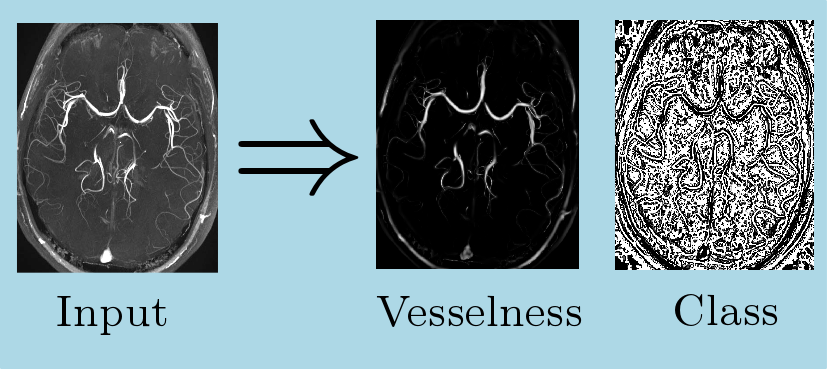 |
IPSDK 4.1.1.1
IPSDK : Image Processing Software Development Kit
|
| image = | multiscaleVesselEnhancement2dImg (inImg,inMVEParams) |
Multiscale vessel enhancement using Frangi's approach.
The MultiscaleVesselEnhancement2dImg algorithm was proposed by Frangi et al. in 1998 [1]. It is an iterative approach used to enhance tube-like features in an image where each scale focuses on a specific tube width range.
The algorithm steps are applied for each pixel, for this reason, we avoid the notation of the coordinates  in the following. For a given scale
in the following. For a given scale  , the algorithm computes at each pixel the Hessian matrix
, the algorithm computes at each pixel the Hessian matrix  . Its eigen values
. Its eigen values  are then extracted and sorted in order to identify :
are then extracted and sorted in order to identify :
![\[ \vert \lambda_1 \vert \leq \vert \lambda_2 \vert \]](form_609.png)
A blobness coefficient  and a structureness coefficient
and a structureness coefficient  are then calculated from
are then calculated from  and
and  :
:

The vesselness for a scale  , noted
, noted  , is finally computed as a combination of these coefficients. For bright features on dark background, this measure can be expressed as:
, is finally computed as a combination of these coefficients. For bright features on dark background, this measure can be expressed as:
![\[ \nu_s = \begin{cases} 0& \text{if } \lambda_2 > 0 \\ \exp \left(-\frac{R_B^2}{2 \beta^2} \right) \left( 1 - \exp \left(-\frac{S^2}{2c^2} \right) \right) &\text{otherwise} \end{cases} \]](form_614.png)
Where  and
and  are respectively the blobness and structureness sensitivity thresholds.
are respectively the blobness and structureness sensitivity thresholds.  is an input parameter and
is an input parameter and  is calculated as:
is calculated as:
![\[ c = \frac{1}{2} \max_{\textbf{x} \in \Omega} \left( \Vert H(\textbf{x}) \Vert \right) \]](form_616.png)
Where  is the image domain and
is the image domain and  is the Hessian matrix of the image at pixel
is the Hessian matrix of the image at pixel  .
.
For dark features on bright background, the condition  becomes
becomes  .
.
The final result is an image containing the maximum value of  along all the scales on each pixel:
along all the scales on each pixel:
![\[ \nu(\textbf{x}) = \max_{s \in Scales}\left( \nu_s(\textbf{x}) \right) \]](form_622.png)
Where  is the collection of scales given as input parameter.
is the collection of scales given as input parameter.
The algorithm parametrization is done using the MVEParams data item, which contains:
 threshold (by default,
threshold (by default,  ),
),Moreover, the algorithm allows the user to provide a class image, with type UInt8. If this image is set, the algorithm will fill it by the scale index corresponding to the maximum  :
:
![\[ OutOptClassImg(\textbf{x}) = argmax_{s \in Scales}\left( \nu_s(\textbf{x}) \right) \]](form_625.png)
Here is an example of vessel enhancement on a 2d gray level image with the scales  and its corresponding class image:
and its corresponding class image:

The input image has been downloaded from wikipedia: https://commons.wikimedia.org/wiki/File:Mra-mip.jpg (Attribution: By SBarnes (Own work) [CC BY-SA 3.0 (https://creativecommons.org/licenses/by-sa/3.0) or GFDL (http://www.gnu.org/copyleft/fdl.html)], via Wikimedia Commons)
[1] "Multiscale vessel enhancement filtering", Frangi, A. F.; Niessen, W. J.; Vincken, K. L. & Viergever, M. A., Medical Image Computing and Computer-Assisted Intervention - MICCAI '98, Springer Verlag, pages 130-137, 1998